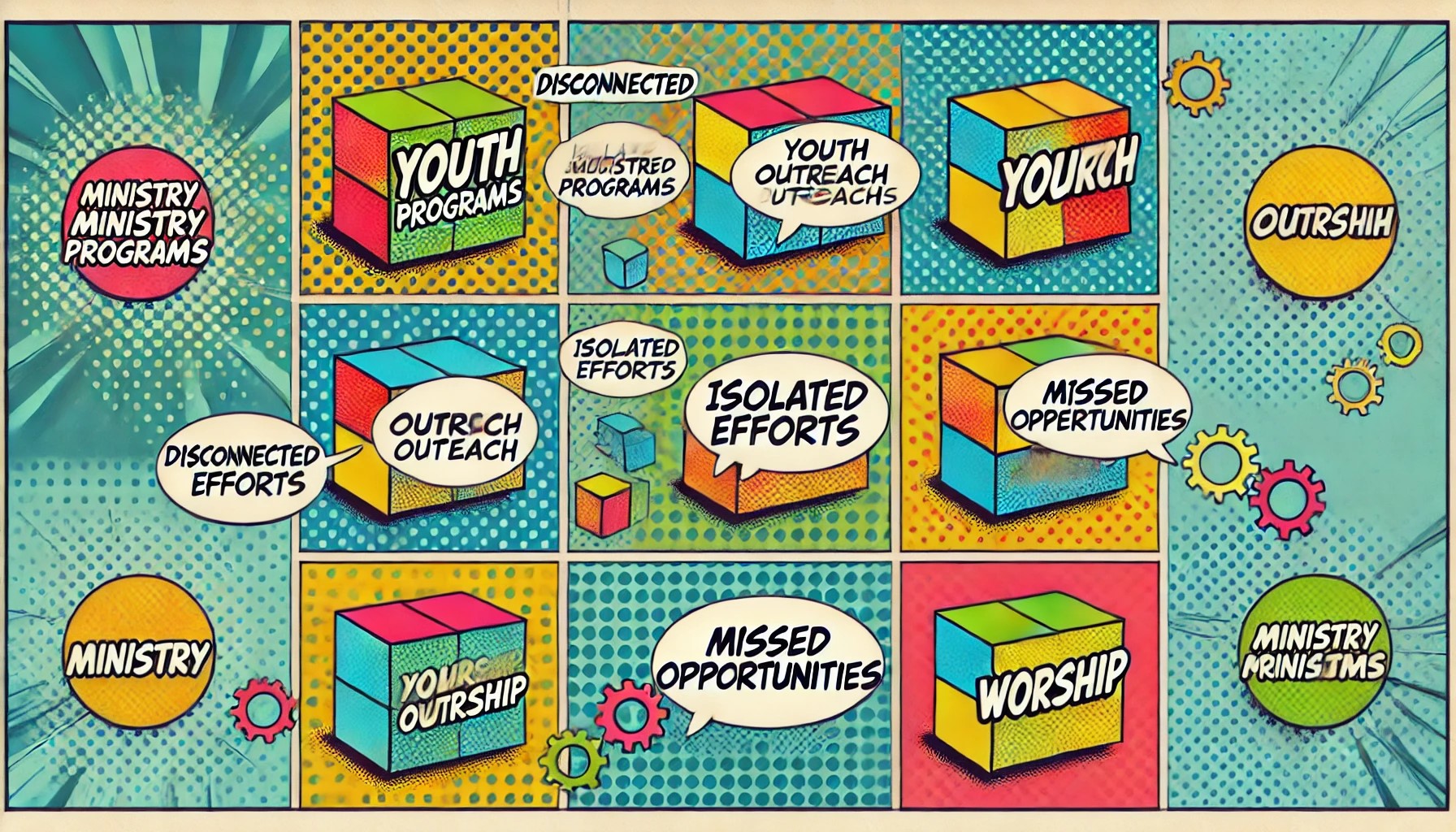Beyond Silos: How Churches Can Build a Unified Mission Across Ministries

Embracing Unified Purpose: A Path to Collective Growth—
Have you ever wondered why the church, a symbol of unity and togetherness, sometimes operates in silos? Well… we didn’t learn it from Jesus… or Paul… or Peter… so where did this division creep in?
Churches often strive to embody unity and shared purpose, yet they may encounter challenges when ministries operate independently. This divide can hinder the church’s overarching mission and community impact. By breaking down these silos, and fostering a spirit of collaboration, churches can create a more harmonious and effective ministry. Emphasizing shared goals, open communication, and mutual support among various ministry groups can transform the church environment, allowing it to more fully reflect its spiritual calling of compassion and unity.
In an age where unity can transform not just communities but entire societies, it’s alarming how many churches still struggle with ministry silos. These barriers prevent congregations from truly realizing their potential as dynamic, interconnected bodies of faith. While each ministry—from outreach to worship—plays a pivotal role in church life, the lack of cohesion often leads to fragmented visions and missed opportunities.
The Problem of Ministry Silos
Ministry silos arise when different church groups work in isolation, each focusing on its goals without aligning with the broader mission. Though often unintentional, these silos create significant challenges:
- Fragmented Vision: Ministries may lose sight of the church’s overarching mission, leading to a disjointed message.
- Wasted Resources: Duplicate efforts can drain time, volunteer energy, and financial support.
- Community Disconnect: Members deeply involved in one ministry might feel disconnected from others, leading to cliques or internal divisions.
- Leadership Burnout: With no unified direction, leaders may feel overwhelmed by managing separate initiatives.
The Impact on Clergy Burnout
Clergy members, often seen as the pillars holding up church communities, are particularly vulnerable to the pressures imposed by ministry silos. The isolation inherent in siloed work environments can lead clergy to experience burnout at an accelerated pace. When each ministry operates independently, clergy are forced to juggle multiple responsibilities without the support of a cohesive team, stretching their emotional and spiritual resources to the limit. Over time, this constant strain can deplete their energy and passion, leaving them feeling empty and uninspired. As a result, some clergy may shift into “cruise control,” relying on outdated methods that no longer serve the current needs of the congregation. This reluctance or fatigue in exploring new tools or strategies perpetuates a cycle of inefficiency and stagnation.
How to Foster Unity and Break Down Silos in Your Church

- Shared Vision and Mission: A unified church cultivates a collective understanding of its mission, reducing competition for resources. This often requires ongoing dialogue and reflection to ensure that all members feel heard and included in the church’s goals, fostering a sense of purpose that drives collaborative efforts.
- Efficient Resource Allocation: When ministries work together, they can pool resources and avoid duplicating efforts. By allocating resources wisely, churches can invest in impactful programs, ensuring that their financial and human resources advance their mission in meaningful ways.
- Stronger Relationships: Breaking down silos creates opportunities for different groups to collaborate and build relationships, strengthening the church community. This process often involves intentional team-building activities and open communication, essential in nurturing trust and empathy among diverse church members.
- Effective Leadership: With a clear, unified vision, leaders can provide guidance and support to all ministries, avoiding burnout and promoting cohesive growth. True leadership involves being a model of collaborative spirit, encouraging innovation and celebrating shared successes within the church.
- Efficient Resource Use: Collaboration maximizes impact through shared events, cross-ministry projects, and pooled budgets. This strategic approach allows churches to tackle larger and more complex initiatives, enhancing their ability to meet the needs of their congregation and community effectively.
- Stronger Community Bonds: Encouraging involvement in multiple ministries fosters a sense of belonging and shared ownership of the church’s mission. By rotating leadership roles and incorporating diverse perspectives, individuals feel more valued and engaged, contributing to a vibrant and unified community.
- Holistic Impact: Interconnected ministries lead to holistic outreach and spiritual life. For instance, integrating refugee stories into the liturgy enriches both worship and outreach efforts. This holistic approach ensures that the church’s activities resonate with the real lives and spiritual journeys of its members, creating a deep and lasting impact.
A Unified Church: A Stronger Witness
A unified church is a powerful testament to its community and the world. Breaking down silos is not merely about efficiency; it’s about embodying the unity Christ calls us to. By fostering collaboration, open communication, and a shared vision, churches can transcend silos and become thriving, integrated bodies working together for the greater good.
As we work towards a unified church, it’s important to reflect on our individual roles and how they contribute to the greater whole. We must remember that each ministry has a unique purpose and gift, but when combined with others, can create an even greater impact.
In order for this collaboration to be successful, we must also approach it with a spirit of humility and openness. Each ministry may have their own methods and approaches, but by coming together and learning from one another, we can strengthen our overall mission as a church.
But beyond just working together internally, a unified church also sends a powerful message to the outside world. When we break down barriers between ministries and work towards common goals, we show that we are a united body, brought together by our love for Christ. This can be a powerful witness to those outside the church, showing them the transformative power of unity and love.
Navigating Conflict: Insights from Family Systems Theory

Conflict often arises when churches attempt to break down ministry silos, as deep-seated traditions and values can clash with new initiatives. Drawing from the insights of family systems theory, one might consider the church as an interconnected emotional system where changes in one area ripple throughout the entire community. This perspective suggests that resistance to change is not necessarily detrimental; rather, it highlights underlying tensions that require addressing. Healthy leadership, as posited by Rabbi Edwin Friedman, involves managing conflicts with a “non-anxious presence,” guiding congregants through transition while remaining calm and open to dialogue.
Leadership figures, like John Kotter, emphasize the importance of continuous communication and the articulation of a shared vision to help communities through transformation. Similarly, Brené Brown advocates for vulnerability in leadership, encouraging leaders to openly address challenges and value divergent perspectives. By integrating these leadership principles, churches can accept conflict as a natural element of change and use it as an opportunity for growth and deeper understanding.
For example, to unify the church community, leaders might establish intentional spaces where members can articulate their concerns and seek companionship in their differences. By embodying a steady presence and facilitating open discussions, church leadership can align transitions with their mission, ensuring that every voice is heard and respected. In doing so, churches can cultivate a more unified and compassionate environment, reflecting their commitment to togetherness and shared spiritual growth. This approach encourages reflective and compassionate leadership, fostering a sense of interconnectedness within the church community.
Serving Together: A Deeper Connection

Volunteering across ministries not only helps address resource shortages, but it also creates opportunities for deeper connections among members. When we serve alongside one another, we get to know each other on a more personal level and build relationships beyond just Sunday worship.
These connections can bridge generational gaps, cultural differences, and even theological disagreements. As we work towards a common goal, we learn to appreciate and respect each other’s unique perspectives and backgrounds.
By serving together, we also have the opportunity to share our own personal stories and testimonies with one another, strengthening our bond as brothers and sisters in Christ. This not only creates a more unified church, but also a more loving and compassionate community.
The Power of Prayer
In addition to serving together, prayer is another powerful tool for unifying the church. When we come together in prayer, we are reminded that we are part of something bigger than ourselves. We lift up our individual concerns and needs, but also the needs of our church body as a whole.
Prayer also allows us to humble ourselves before God and seek His guidance and wisdom for how we can work together towards His kingdom.
Conclusion
Breaking down ministry silos presents both practical and spiritual challenges for churches today. It demands intentional leadership, a shared vision, and a commitment to unity. Yet, the rewards—a vibrant community, better resource stewardship, and a holistic witness—are immense. When ministries unite in service to a common goal, the church can more effectively fulfill its mission, bringing God’s love to life in transformative ways.
Let’s open a dialogue in your church community. Discuss the barriers, share your dreams, and begin the journey toward a unified mission. Together, we can overcome silos and elevate our impact, becoming beacons of unity and love in a divided world.
In summary, viewing the church as an emotional system allows leaders to embrace change and conflict as natural components of growth. By implementing principles of healthy leadership focused on communication, vulnerability, and inclusivity, churches can navigate transitions with grace and unity. Through this process, they can emerge stronger and more connected in their shared spiritual journey. Let us continue to reflect on our role as leaders in the church and cultivate a culture of compassion and growth for all members of our community. So let us strive to be non-anxious presence that guides our congregants through change, fosters open dialogue and embraces diversity with empathy.
Related Posts
The Night Love Took A Towel
There’s a sacrament we almost forget. It doesn’t shimmer with stained glass or…
April 16, 2025The Broken and the Beautiful: A Les Paul’s Lessons on Scars, Redemption, and Tone
A photograph is an odd thing. It captures a sliver of time, reducing the vastness…
February 1, 2025

